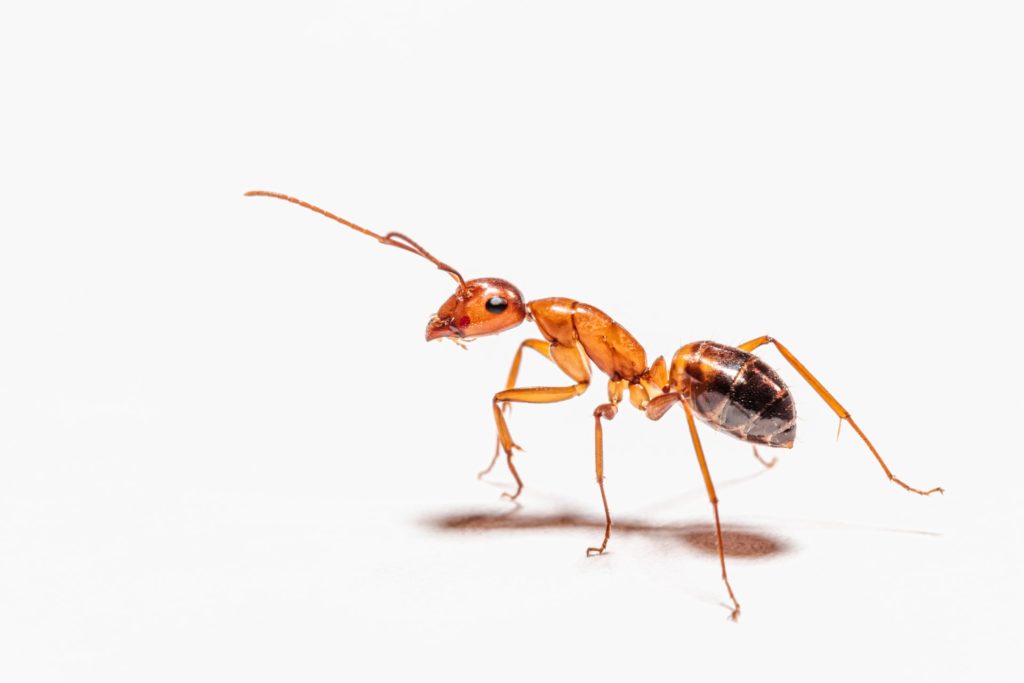How to control ants in your restaurant and get rid of them fast.
Ant control is vital in all restaurants and food facilities. The humble ant is quiet a creature. A little bit about the ant.
Ants belong to the order of insects known as Hymenoptera which includes some of the most highly evolved insects such as wasps and bees. They have a social order or caste system. Nest building, looking after young and searching for food is undertaken by worker ants, all sterile females. Reproduction is performed by fertile females or queens and male ants. The male ant dies not long after mating. All ants have an elbowed antenna, biting mouthparts and a narrow waist between the abdomen and thorax.
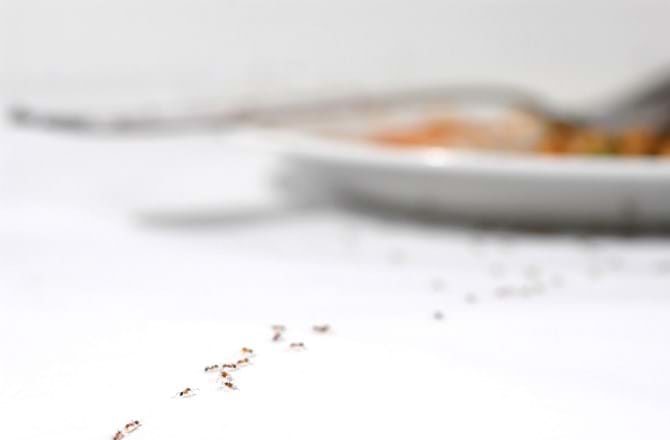
Species Identification
Species identification is crucial for the successful treatment and control of ants in restaurants. Correctly identifying ants allows you to understand behaviour, giving you a better chance of eradicating them.
There are thousands of ant species in Australia but only a few are considered pests.
Ant identification is relatively simple due to their three distinct body regions: head, thorax and abdomen, as well as antennae. Despite similar construction, ants vary in overall appearance.
1. The Pharaoh Ant
Scientific name: Monomorium pharaonis
Adult size: 2 mm
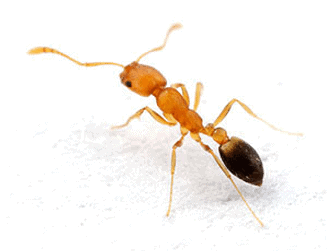
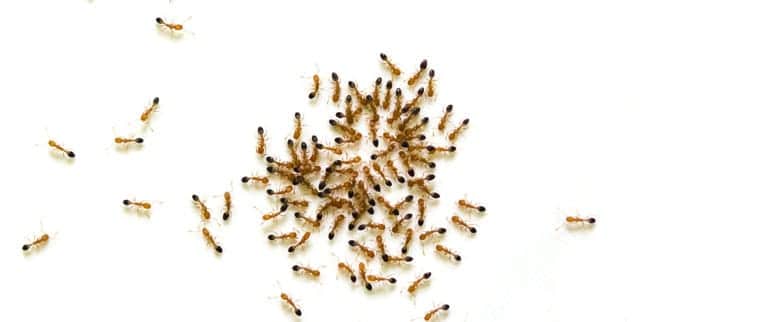
The Pharaoh Ant, Monomorium pharaonis, is a minuscule in size, measuring up to 2 mm. yellow or light brown, almost transparent ant. It is a major indoor nuisance. Pharaoh ants are a tropical species, but they thrive in heated buildings anywhere.
They feed on a wide variety of foods including jellies, honey, shortening, peanut butter, corn syrup, fruit juices, baked goods, soft drinks, grease, dead insects, toothpaste and even shoe polish. They can also gnaw holes in silk, rayon and rubber goods.
Pharaoh ants use pheromones as the primary means of communication.
Parts of certain colonies often migrate to new locations. Nests can be very small, located between sheets of paper, in clothing or laundry, furniture, foods, etc. Nests usually occur in a variety of places including wall voids, under floors, behind baseboards, in trash containers, under stones, in cement or stonewall voids, in linens, light fixtures.
They prefer dark, warm areas near hot water pipes and heating taps. They are ‘trail-making’ ants and often are found foraging in drains, toilets, washbasins and other unsanitary sites, as well as in sealed packs of food.
Pharaoh ants are often exterminated by placing baits, consisting of ground liver mixed with boric acid, in places where the ants forage. Renewing the baits once or twice may be necessary. It is recommended not to exterminate using sprays and dusts because they will cause the Pharaoh ants to scatter.
Pharaoh ant queens are known to lay hundreds of eggs throughout their lifetime. They breed continuously throughout the year and have multiple queens in a single colony. Nests can be very small, often located between clothes or books or even papers.
2. The Black House Ant
Scientific name: Ochetellus glaber.
Adult size: 3 mm
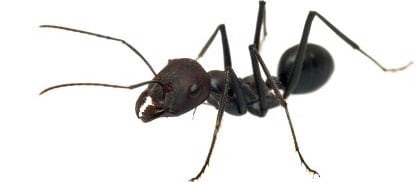
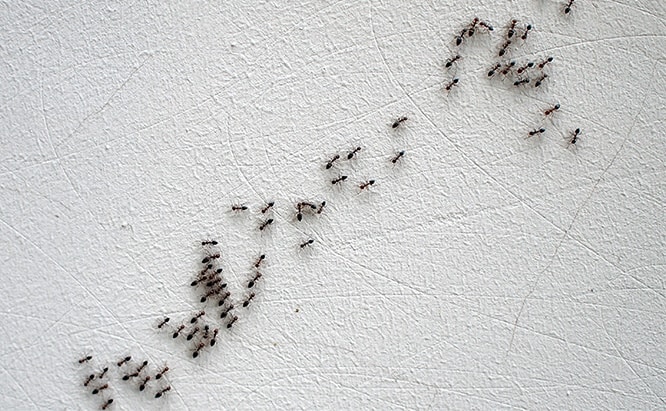
The Black House Ant is shiny, black, and is found in urban and rural areas. This ant has a prominent node (petiole), a stocky body and two antennae on their heads.
Infesting home and buildings in search of food and water, black house ants are especially attracted to sweet foods. Travelling widely in search of food, they follow well defined pheromone trails. They cluster around the food source. They are omnivorous, feeding on insects and worms, as well as vegetation, such as small seeds. Black house ants usually nest under stones, dry logs, and cracks in building foundations. The species can commonly be found nesting in gardens. The black house undergoes full metamorphosis in 44 days.
3. The White Footed Ant
Scientific name: Technomyrmex Albipes
Adult size: 3mm
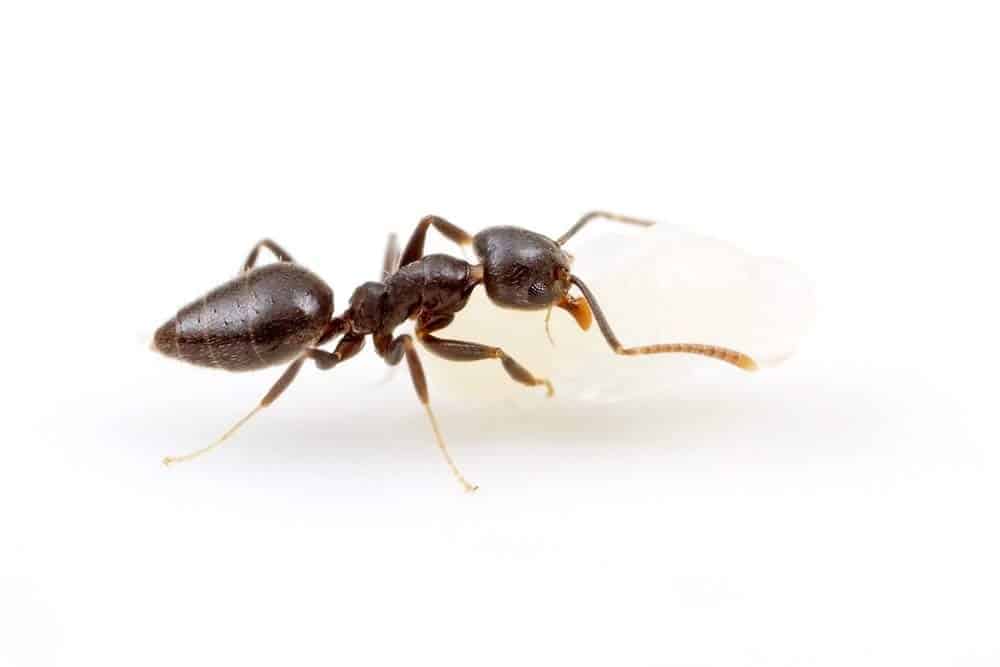
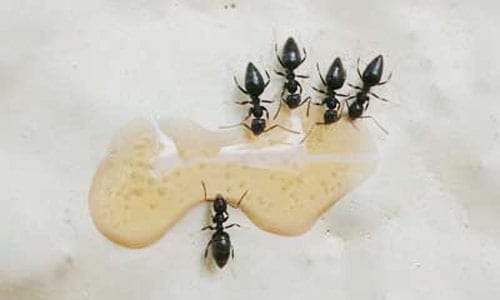
The White Footed Ant is a small, black to brownish-black ant with yellowish-white feet. Although white-footed ants are strongly attracted to sweet foods they will also feed on dead insects and other protein. They are commonly found foraging along branches and trunks of trees and shrubs.
Forager ants lay trail pheromones. Often the same trails are observed between a nest and resource for months at a time. In and on structures, foragers tend to follow lines, such as an edge of an exterior wall panel, which eventually leads to some small opening to the interior. Frequently, the white-footed ant finds its way inside wall voids where they follow electrical cables into various rooms, especially kitchens and bathrooms, where liquid and solid foods can be found resulting in heavy trailing activity.
The white footed ant nests at or above ground level in numerous locations within the landscape and buildings. Nests are frequently found in trees and bushes, tree holes, under palm fronds leaves on trees, in loose mulch, under debris, in leaf-litter (both on the ground as well as in rain gutters), wall voids and attics. Nests tend to be found outside of structures more than inside. Preferred nest sites provide proximity to moisture and food sources and protection from predators and environmental extremes.
The white footed ant is an extremely difficult pest to control due to the large size of its colonies, but control can be achieved. Baits are effective for many sweet-feeding ant species. No surface or residual treatments with liquid insecticides have yet been found to be effective for controlling these ants. Management has only been accomplished by treating infested buildings exclusively with baits containing borates. It is critical that all populations of white footed ants on the property being treated are identified so that baits can be made available to each population. Since liquid baits tend to slowly dry out, it is important that fresh baits are always available until the target population has been controlled. Although bait toxicants may not be orally transferred between workers, they can still kill enough workers to cause death of brood by starvation. In addition, it is also thought that very slow acting bait toxicants may, with time, end up in the trophic eggs.
Infestations can frequently be treated by placing liquid baits along trails on the exterior of a property. A key aspect of white footed ants control involves trimming trees and shrubs surrounding the structure to stop ants from ‘bridging’ (trailing from the vegetation onto the structure). The best policy is to not have any vegetation touching exterior walls. Placing liquid baits at the base of these trees or along branches can also be helpful. Ant trails coming from neighbouring properties via adjoining vegetation, fences, or across lawns, must also be treated.
4. The Coastal Brown Ant
Scientific name: Pheidole megacephala
Adult size: 2.5 mm
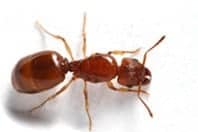
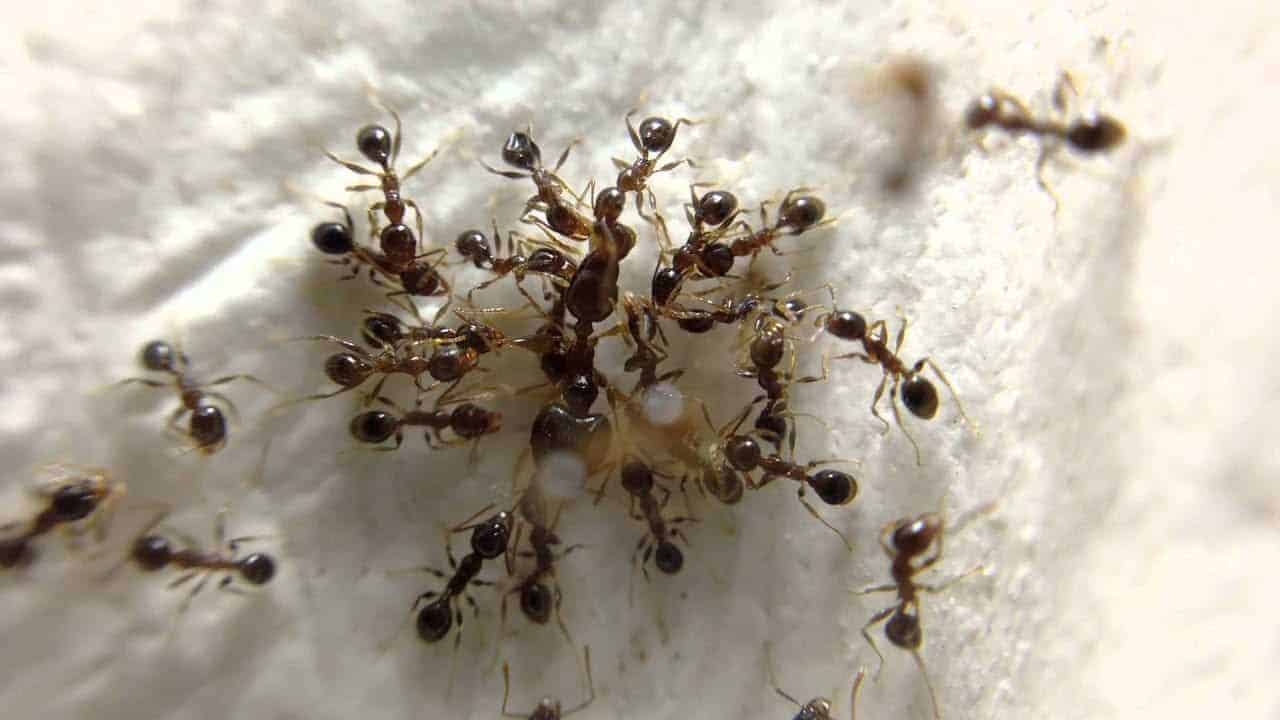
The Coastal Brown Ant is yellowish-brown.
Also called big-headed ants, the coastal brown ant is fairly small, growing up to no more than 2.5mm in size.
These ants nest mainly in the soil and build along pathways, in gardens, against walls, under houses and, if in large enough numbers, can cause damage to lawns. Coastal brown ants can excavate leaving mounds along foot paths and other areas. They prefer sunny, dry areas to nest but will nest above ground if soil is unavailable. They can also be found nesting in termite tracks and have been known to invade external electrical appliances such as hot water systems.
Coastal brown ants prefer fatty foods but will attack seeds, meats, insects, fruit, honeydew from aphids, sweet foods, fats and grease. Adults cannot ingest solid food particles but will ingest liquids which are pressed out of food material. The larvae are entirely dependent on workers for food. While young larvae are fed in liquids, the older larvae are fed on small food particles which they can ingest. Coastal brown ants can be vectors of disease organisms such as dysentery, smallpox and bacteria such as Salmonella.
Coastal brown ants hatch in about three to four weeks. However, the queen can lay close to 300 eggs per month and each queen can live up to several years.
Known for their incredibly invasive nature, the coastal brown ant can quickly establish a super colony with multiple queens. Each queen laying up to 300 eggs per month and living several years. This species can cause a mass infestation.
Identification information sourced here.
How to keep ants out of restaurants.
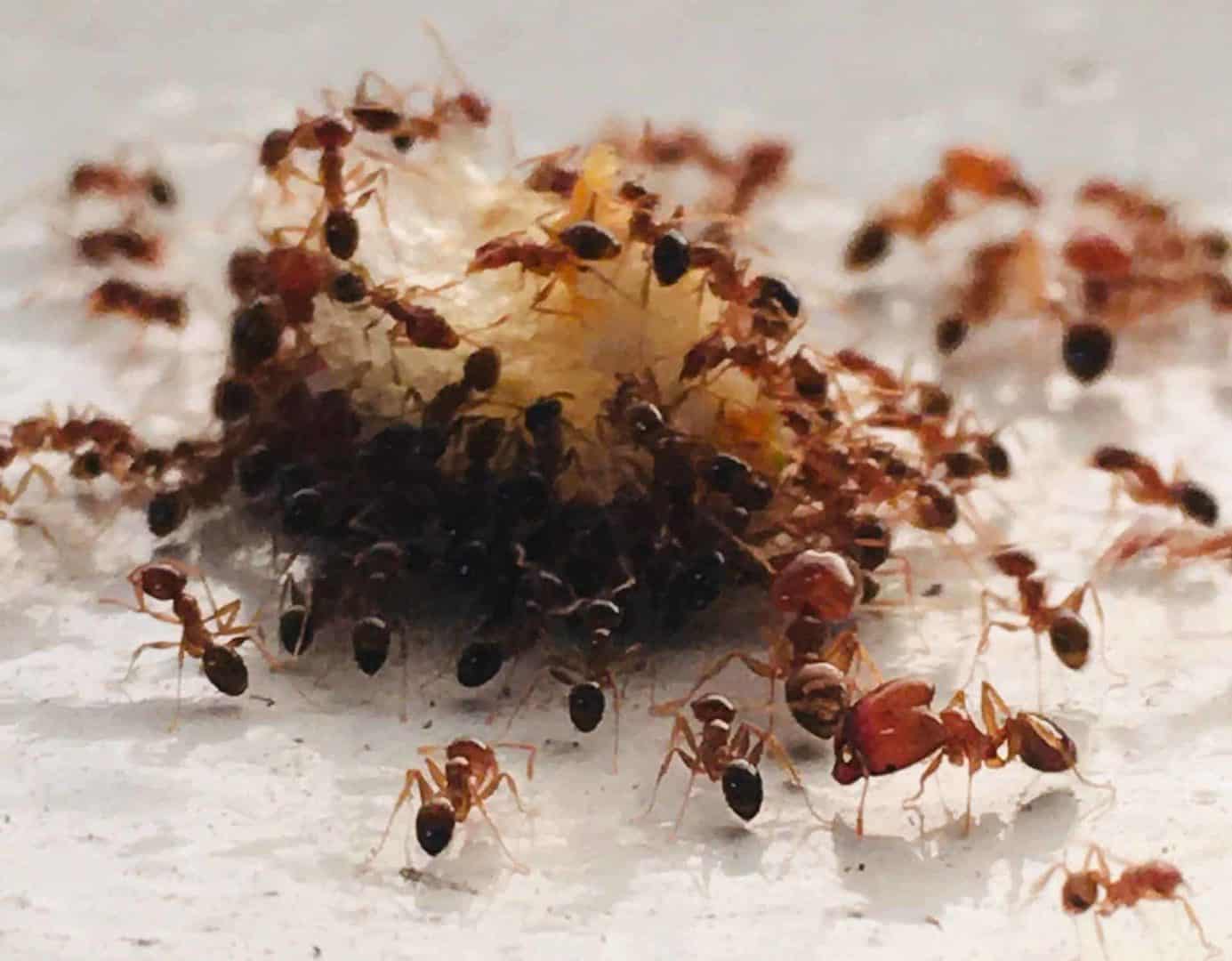
Outdoor tasks
- Trim or move pots plants around the building so branches do not touch the walls, windows or roof.
- Ants can gain entry through a tiny crack or gap. Check the exterior for possible entry points around vents, window, doors, walls. Repair / fill where necessary.
- Install or replace weather strips on external doors.
- Keep loading dock clean and tidy.
- Empty and clean bins regularly. Keep lids closed.
- Pressure wash outdoor eating areas.
- Avoid compost, mulch and lawn clippings piling up.
Indoor tasks
- Clean all spills immediately.
- Minimise their access to food.
- Keep food containers clean. Wipe necks of sauce bottles etc.
- Store food in airtight, sealed containers.
- Ensure lids fit properly and create an airtight, ant proof seal.
- Keep containers refrigerated where suitable.
- Sweep and vacuum daily.
- Leave any dirty dishes submerged in a tub of water at close.
Locating colonies
Make a sugar syrup mix and fill some jar lids. Position the sugar syrup throughout the kitchen at the end of the day. Leave a mix in front of doors, windows, on counters, dry store areas and anywhere you have seen ants.
Check the lids the next morning. Follow the ant trails back to the entry points. Make any necessary repairs to seal up entry points. It is possible the ants are nesting inside the restaurant. These syrup traps will help you locate any indoor nesting sites.
Outside, look for ant nests along pathways and in grass areas. Loose or mounded soil can indicate a nest.
Coastal Brown Ants nests
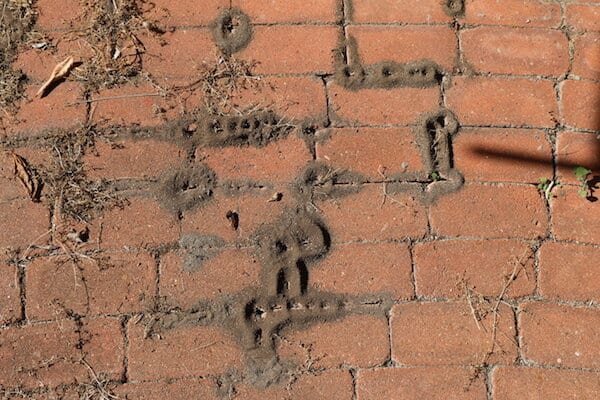
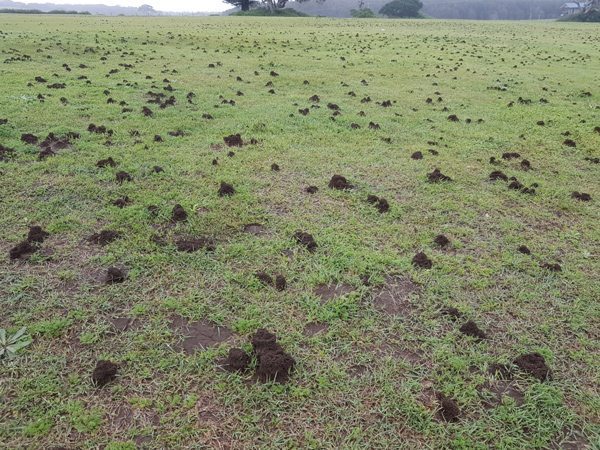
Control of ants in restaurants
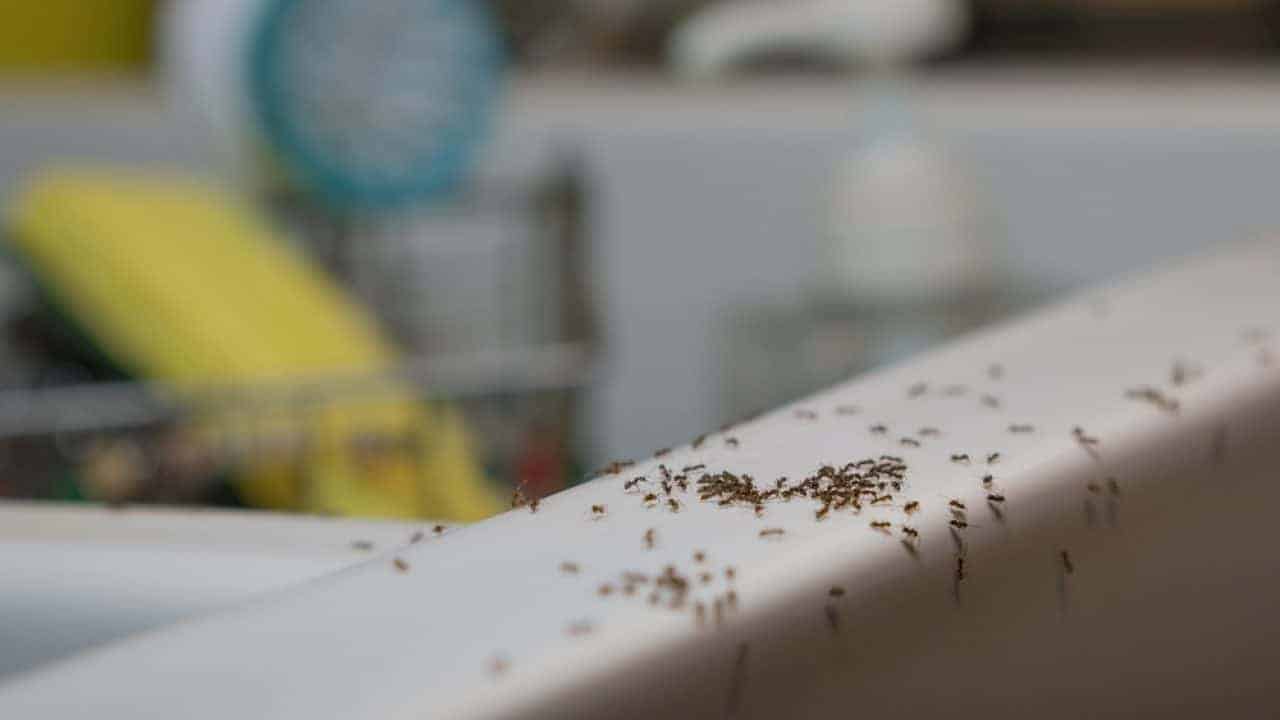
Pheromone trails
Ants communicate via pheromone scent trails. Wipe all surfaces daily to remove trails. Try a solution of 50-50 white vinegar and water to clean hard surfaces including floors and countertops. Spray around your windowsills, doorways – any places you see ants.
Barrier
Barrier treatments are used for control and removal. They can be in a powder or spray form. Barrier treatments prevent new ants from entering the premises. Barrier or perimeter treatments work well with ants that nest outdoors. In this case a perimeter treatment of the premises is often all that is required. Particularly if spraying for Pharaoh ants. Spreading salt where ants enter may help keeping ants out. Table salt is one of the best and the cheapest ways to get rid of ants naturally.
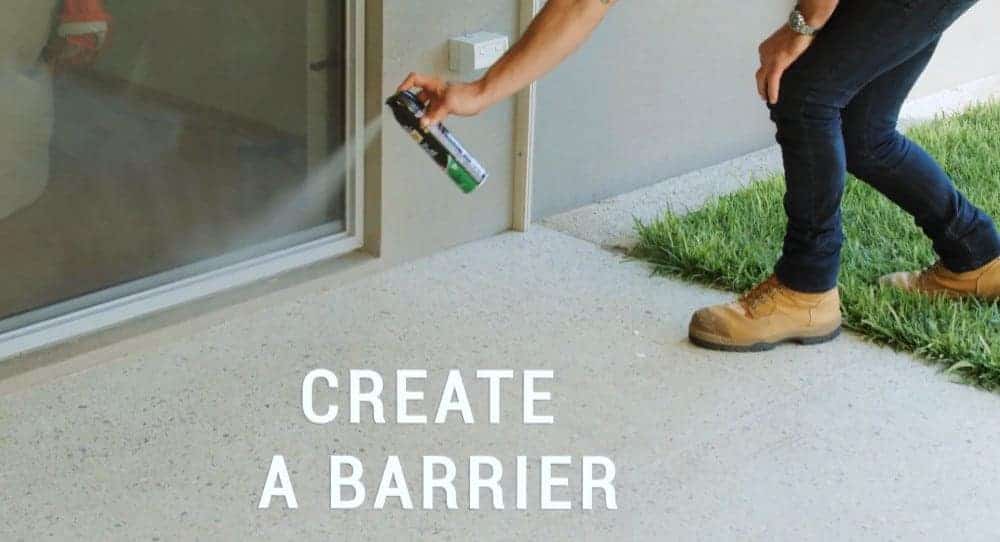
Baiting
Indoor ant treatments rely heavily on ant baits. Ant baits consist of a food matrix and a slow acting insecticide. The bait is introduced in restaurant-safe bait stations. Foraging ants find the bait irresistible and take it back to the nest where it is spread throughout the nest, killing the queen and the colony. This method can be a very successful way to eliminate the problem at it source. It is important to use a slow acting bait so ants have a chance to get the bait back to the colony. Ant baits consist of a food matrix and a slow acting insecticide. They come in various flavours and it will depend on the needs of the colony as to the type of bait they take. Sugar/carbohydrate-based bait, a grease/fat-based bait, or a protein-based bait. If ants are not attracted to the bait you are putting out, try another. Once ants start a bait – do not move it.
Dust and spray
Be careful with these products when working with ants. Many residual dusts and sprays can stress the ants and cause colony “budding”. This is where the ants split up and begin new colonies as a survival measure. Budding only makes your problems greater, dividing and scattering the colonies.
Non repellent sprays
Non-repellent insecticides are ideal because they cannot be smelt or tasted by ants. The ant will not try to escape it. For this reason, non-repellent insecticide can be used near ant baits. As they are undetectable, they do not contaminate the lures inside the baits. This ought to be considered as it is not the case with repellent sprays and dusts. If one negates the other, it is a waste of money. If you are using a spray choose a non-repellent type unless treating the nest itself.
Treating the nest
The best treatment is to go directly to the nest with an appropriate insecticide.
Keeping on top of your restaurant pest control
As is the case with all pest control, it is vital to have staff reporting on any critter activity. Observations of ant locations, dates and number of ants seen, will help pinpoint problem areas and signal spots to concentrate control efforts.
Staff need to know where to record their observations. Where do you keep the Pest Activity sheet? It is important any information is acted on in a timely fashion. Good response times may mean the difference between putting out a few dots of ant bait or trying to eradicate a bigger problem.
In every way, pest control is a team sport. All staff need to maintain regular cleaning routines. Hygiene is perhaps the single most critical aspect to a successful pest control program. Chemical control alone will not eradicate pest issues.
Pest control resources & downloads.
Pest control checklist
The Pest Control Checklist For Restaurateurs, Matradee’s, Chef’s & Hospitality Managers.
Pest sighting register
The Pest Control Sighting Register. Make sure your staff report any pest activity here.
The Fly Lady Insect Spray
Food safe pyrethrum insect spray in automatic dispensers.
Multiple units are set up to keep indoor spaces insect free. Used in front of house dining areas, dry stores, and kitchen spaces. Being airborne automatic spray dispensers are unlikely to penetrate the nooks and crannies. The spray will float in the air and repel all flying insects. These sprays are not a fast knockdown product. This makes the product highly suitable for food spaces. Insects are forced to leave the space, thus not dying in prep or around customers. The spray is photo biodegradable, meaning it breaks down in light and air and does leave a residue on surfaces. Whilst ideally suited to fly control, automatic fly control units are a worthwhile preventative measure for all insects. Purchase food friendly pest control aerosols and dispensers here.
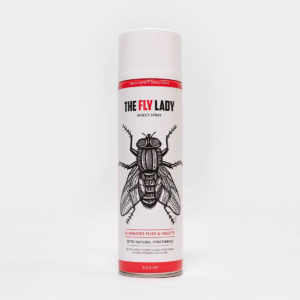
Food Friendly Pyrethrum Aerosol Spray
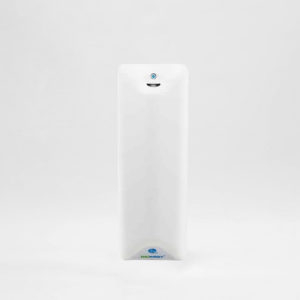
Automatic Dispenser
FAQ
What does an ant infestation look like?
What does an ant nest look like?
What causes ant infestations?
How can I prevent ants from entering my premises?
Using a barrier spray to create an impassable chemical barrier and ensuring branches and foliage do not contact the building or roof.
What’s a natural ant repellent?
Sugar and borax
Do ants nest inside or out?
How quickly do ants breed?
Must l use a pest controller in my restaurant?
This answer from food authority nsw.
“If you perform pest control treatments yourself, make sure that any chemicals or baits used are suitable and approved for use in food premises and do not contaminate food or food contact surfaces.”
Visit the Food Authority NSW Gov Au to read their pest control fact sheet
How do l know if a pest control product is safe to use in a restaurant kitchen?
Never decant chemicals as this increases chances of there being a mix up. Keep chemicals in original containers unless proper labels can be arranged. Always store in appropriate area away from the food space.
Is ant keeping a thing?
Please note: Live ant sales not permitted to Western Australia or Tasmania.
Ants: identification and control Westren Australia
Ants: identification and control Victoria
The Victorian State Government has an article on ants and their control. Click here to take a look.
